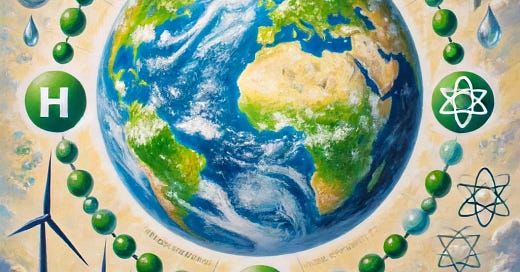Green Hydrogen: The Fuel of the Future?
A Paradigm Shift to Non-Greenhouse Clean Fuel, or Merely a Niche Opportunity?
Introduction
Hydrogen, particularly green hydrogen, is being hailed as a future fuel capable of revolutionising the energy landscape. As an ideal fuel, it produces energy without emitting carbon dioxide or other pollutants, with water being its only byproduct. This article delves into the potential of hydrogen as a clean energy source, tracing its technological timeline and exploring the current global status, safety, regulatory concerns, environmental impacts, and the situation in India.
Definition and Importance of Hydrogen
Hydrogen is a clean energy carrier that holds promise for a sustainable future. Its role in the energy transition towards greener alternatives is increasingly being recognised, given its potential to significantly reduce carbon emissions across various sectors.
Origins and Early History of Hydrogen Technology
The journey of hydrogen technology began in the 1600s with early experiments1. In 1671, Robert Boyle produced hydrogen by reacting iron filings with acids. The existence of hydrogen as a distinct element was established by Henry Cavendish in 1766.
In 1800, William Nicholson and Anthony Carlisle discovered the process of electrolysis, which produces hydrogen and oxygen from water. In 1839, Christian Friedrich Schönbein discovered the fuel cell effect, demonstrating that hydrogen and oxygen could combine to produce water and electricity. Sir William Grove later developed the first fuel cell, known as the "gas voltaic battery."
During the early 1800s, hydrogen was used for gas lighting in homes until electric lighting took over in the early 1900s. The mid-20th century saw NASA using liquid hydrogen as rocket fuel, marking a significant milestone in hydrogen technology.
Current Global Status of Hydrogen
As of 2021, the vast majority of global hydrogen production (96%) comes from fossil fuels, primarily natural gas (62%) and coal (21%), with only 4% produced through electrolysis. Of this, a mere 1% is derived from renewable energy sources. In 2022, global hydrogen production reached 95 million tonnes, reflecting a 3% increase from the previous year, though low-emission hydrogen remained less than 1% of total production.
Hydrogen's use as an energy carrier is currently limited, predominantly in road vehicles. As of June 2021, over 40,000 fuel cell electric vehicles, 6,000 fuel cell buses, and 3,100 fuel cell trucks were in operation globally. Many countries have set net-zero emissions targets, incorporating low-emission hydrogen into their plans, yet mainstream low-emission hydrogen production is still in its infancy.
Safety and Regulatory Concerns
Hydrogen's wide flammability range and low ignition energy compared to gasoline or natural gas make safety a critical concern. Adequate ventilation and leak detection are essential for safe hydrogen handling. Some metals become brittle when exposed to hydrogen, necessitating careful material selection for hydrogen systems. Training in safe hydrogen handling practices is vital, and global safety standards are evolving to address these challenges.
Environmental Concerns and Oil Industry Opposition
While environmental groups support green hydrogen produced from renewable energy, they have reservations about blue hydrogen, which is derived from natural gas paired with carbon capture, fearing it may extend fossil fuel dependency. The oil and gas industry has been lobbying for blue hydrogen, spending significant amounts in the process. Critics argue that this is a strategy to safeguard their interests against the growing renewable energy market.
Status in India
a.) Government Initiatives and Policies
India has launched several ambitious initiatives to promote green hydrogen production and usage. The National Hydrogen Mission, initiated in 2021, aims to establish India as a global hub for green hydrogen production and export. This mission supports manufacturing through incentives and policies, creates demand in specific sectors, and develops a framework for standards and regulations. The Green Hydrogen Policy, released in 2022, offers additional incentives such as a single portal for statutory clearances, the ability for manufacturers to bank unconsumed renewable power, open access to power grids, waiving inter-state transmission charges for plants commissioned before June 2025, and permitting storage near ports. The government has allocated Rs 19,744 crore ($2.4 billion) for the National Green Hydrogen Mission to support domestic manufacturing, pilot projects, and R&D. Moreover, several states are implementing their own green hydrogen policies and incentives to attract investments across the value chain.
b.) Hydrogen Production and Consumption
India currently consumes about 6-6.5 million tonnes of hydrogen annually, primarily in refineries and fertilizer plants, most of which is grey hydrogen produced from natural gas. By 2030, India's hydrogen demand is projected to increase to 11-12 million tonnes per annum, driven by industry and transportation sectors. The Government aims for green hydrogen to meet 40-50% of this demand, setting a target of 5 million tonnes per annum of green hydrogen production capacity by 2030, which would require approximately 125 GW of renewable energy capacity addition. Several Indian companies, including Reliance Industries and Adani Group, have announced ambitious plans for green hydrogen production, each committing over $70 billion in investments. Despite challenges such as high production costs, lack of dedicated hydrogen transport and storage infrastructure, and water scarcity, green hydrogen presents a significant economic opportunity for India, potentially saving $246-358 billion in energy imports and positioning the country as a major green hydrogen and ammonia production and export hub.
Summing Up
Hydrogen, with its extensive history, is poised to play a crucial role in the clean energy future. The emphasis on green hydrogen from renewable energy is still developing, yet it is viewed as essential for decarbonising hard-to-electrify sectors like industry and heavy transport. Despite the hurdles of cost, infrastructure, and safety, the momentum towards a hydrogen-powered future is building. The oil and gas industry’s focus on blue hydrogen contrasts with the environmental push for green hydrogen, making the next few years critical in shaping hydrogen's role as a mainstream clean energy solution.
Cautious Optimism
While green hydrogen holds immense potential, cautious optimism is warranted. The journey towards mainstream adoption involves overcoming significant barriers related to cost, infrastructure, and safety. With global initiatives and technological advancements, hydrogen can indeed become a cornerstone of the future energy landscape, heralding a new era of sustainable energy solutions. However, existing and potential competition from solar energy, where major breakthroughs cannot be ruled out, remains a factor to consider in this evolving energy landscape.
If you believe this article would interest someone you know, please feel free to share it anonymously (for us), using any platform that you prefer.
Timeline of Hydrogen Technology Development
Definition
The timeline chronicles significant events and landmark achievements in the development and use of hydrogen technologies.
Importance of Hydrogen
Hydrogen is seen as a clean energy carrier that could play a major role in the future energy transition towards greener alternatives.
Early Discovery
The existence of hydrogen was first recognized as a distinct substance by Henry Cavendish in 1766.
Chronological Overview
1600s: Early hydrogen experiments.
1671: Robert Boyle produces hydrogen.
1766: Henry Cavendish recognises hydrogen as a distinct element.
1800: Nicholson and Carlisle discover electrolysis.
1839: Schönbein discovers the fuel cell effect.
Mid-20th Century: NASA uses liquid hydrogen for rockets.
2021: Majority of hydrogen production from fossil fuels.
2022: Global hydrogen production reaches 95 million tonnes, with minimal low-emission hydrogen.





